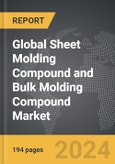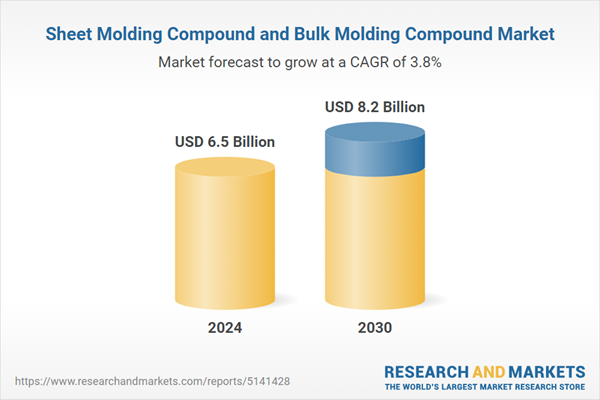The global market for Sheet Molding Compound and Bulk Molding Compound was valued at US$6.5 Billion in 2024 and is projected to reach US$8.2 Billion by 2030, growing at a CAGR of 3.8% from 2024 to 2030. This comprehensive report provides an in-depth analysis of market trends, drivers, and forecasts, helping you make informed business decisions. The report includes the most recent global tariff developments and how they impact the Sheet Molding Compound and Bulk Molding Compound market.
Segments: Fiber Type (Glass Fiber, Carbon Fiber); Resin Type (Polyester, Other Resin Types); Application (Transportation, Electrical & Electronics, Construction, Other Applications).
Geographic Regions/Countries: World; United States; Canada; Japan; China; Europe (France; Germany; Italy; United Kingdom; Spain; Russia; and Rest of Europe); Asia-Pacific (Australia; India; South Korea; and Rest of Asia-Pacific); Latin America (Argentina; Brazil; Mexico; and Rest of Latin America); Middle East (Iran; Israel; Saudi Arabia; United Arab Emirates; and Rest of Middle East); and Africa.
The analysts continuously track trade developments worldwide, drawing insights from leading global economists and over 200 industry and policy institutions, including think tanks, trade organizations, and national economic advisory bodies. This intelligence is integrated into forecasting models to provide timely, data-driven analysis of emerging risks and opportunities.
Global Sheet Molding Compound and Bulk Molding Compound Market - Key Trends and Drivers Summarized
Sheet Molding Compound and Bulk Molding Compound: Are They Paving the Way for Advanced Composites?
Sheet Molding Compound (SMC) and Bulk Molding Compound (BMC) are becoming key materials in high-performance applications due to their lightweight, high strength, and excellent molding capabilities. These composite materials, which consist of thermosetting resins reinforced with fibers, fillers, and additives, are widely used in automotive, electrical, electronics, and consumer goods industries for manufacturing complex, high-strength components. The demand for SMC and BMC is driven by the need for weight reduction, energy efficiency, and superior mechanical properties in automotive and aerospace applications, where they are used to produce body panels, structural parts, and under-the-hood components. The growing trend towards electrification, lightweighting, and sustainability is further propelling the adoption of SMC and BMC in various industries.How Are Innovations in Resin Formulation and Molding Processes Impacting the SMC and BMC Market?
Innovations in resin formulation and molding processes are significantly impacting the SMC and BMC market by enhancing material performance, processing efficiency, and environmental sustainability. The development of low-profile, low-shrink, and low-emission resins is reducing VOC emissions, improving surface finish, and minimizing warpage in molded parts. The introduction of high-flow, fast-curing, and low-density SMC and BMC compounds is catering to the demand for high-performance, lightweight components in automotive and aerospace applications. Advanced molding techniques, such as compression molding, injection molding, and hybrid molding, are enabling the production of intricate and high-precision parts with reduced cycle times and lower production costs. Additionally, the focus on bio-based, recyclable, and sustainable composites is aligning with regulatory requirements and environmental standards, expanding the market's appeal among OEMs and manufacturers.Which Market Segments Are Leading the Adoption of SMC and BMC?
Types of SMC and BMC include standard, flame-retardant, low-density, and conductive grades, with standard and flame-retardant grades being the most widely used due to their high strength, thermal stability, and safety properties. Applications of SMC and BMC span automotive, aerospace, electrical, electronics, consumer goods, and industrial applications, with automotive and electrical being the largest segments due to the high demand for lightweight, durable, and cost-effective components. End-users include automotive OEMs, electrical equipment manufacturers, aerospace companies, and consumer goods producers, with automotive OEMs and electrical equipment manufacturers leading the market due to their focus on lightweighting, energy efficiency, and safety. Asia-Pacific is emerging as a high-growth region driven by rapid industrialization, urbanization, and electric vehicle (EV) adoption.What Are the Key Drivers of Growth in the SMC and BMC Market?
The growth in the Sheet Molding Compound (SMC) and Bulk Molding Compound (BMC) market is driven by several factors, including the rising demand for lightweight and high-performance composites in automotive and aerospace industries, advancements in resin formulation, reinforcement materials, and molding processes, and the increasing use of SMC and BMC in electrical, electronics, and consumer goods applications. The development of high-strength, flame-retardant, and low-emission SMC and BMC solutions with enhanced thermal stability, chemical resistance, and surface quality is driving market adoption among automotive, aerospace, and electrical equipment manufacturers. The focus on sustainable, bio-based, and recyclable composite materials is expanding the market reach among industrial, infrastructure, and renewable energy applications. The growing use of SMC and BMC in automotive interiors, exteriors, and structural components, coupled with the need for fast-cure, high-flow, and low-weight compounds, is creating new opportunities for market growth. Additionally, the increasing investments in R&D for thermal management, electrical insulation, and anti-corrosion applications are further supporting market expansion.Report Scope
The report analyzes the Sheet Molding Compound and Bulk Molding Compound market, presented in terms of units. The analysis covers the key segments and geographic regions outlined below.Segments: Fiber Type (Glass Fiber, Carbon Fiber); Resin Type (Polyester, Other Resin Types); Application (Transportation, Electrical & Electronics, Construction, Other Applications).
Geographic Regions/Countries: World; United States; Canada; Japan; China; Europe (France; Germany; Italy; United Kingdom; Spain; Russia; and Rest of Europe); Asia-Pacific (Australia; India; South Korea; and Rest of Asia-Pacific); Latin America (Argentina; Brazil; Mexico; and Rest of Latin America); Middle East (Iran; Israel; Saudi Arabia; United Arab Emirates; and Rest of Middle East); and Africa.
Key Insights:
- Market Growth: Understand the significant growth trajectory of the Glass Fiber segment, which is expected to reach US$4.8 Billion by 2030 with a CAGR of a 4.2%. The Carbon Fiber segment is also set to grow at 3.3% CAGR over the analysis period.
- Regional Analysis: Gain insights into the U.S. market, valued at $1.7 Billion in 2024, and China, forecasted to grow at an impressive 6.7% CAGR to reach $1.7 Billion by 2030. Discover growth trends in other key regions, including Japan, Canada, Germany, and the Asia-Pacific.
Why You Should Buy This Report:
- Detailed Market Analysis: Access a thorough analysis of the Global Sheet Molding Compound and Bulk Molding Compound Market, covering all major geographic regions and market segments.
- Competitive Insights: Get an overview of the competitive landscape, including the market presence of major players across different geographies.
- Future Trends and Drivers: Understand the key trends and drivers shaping the future of the Global Sheet Molding Compound and Bulk Molding Compound Market.
- Actionable Insights: Benefit from actionable insights that can help you identify new revenue opportunities and make strategic business decisions.
Key Questions Answered:
- How is the Global Sheet Molding Compound and Bulk Molding Compound Market expected to evolve by 2030?
- What are the main drivers and restraints affecting the market?
- Which market segments will grow the most over the forecast period?
- How will market shares for different regions and segments change by 2030?
- Who are the leading players in the market, and what are their prospects?
Report Features:
- Comprehensive Market Data: Independent analysis of annual sales and market forecasts in US$ Million from 2024 to 2030.
- In-Depth Regional Analysis: Detailed insights into key markets, including the U.S., China, Japan, Canada, Europe, Asia-Pacific, Latin America, Middle East, and Africa.
- Company Profiles: Coverage of players such as Astar S.A., Bo-Witt Products, Inc., Continental Structural Plastics, Inc., Idi Composites International, Koninklijke Ten Cate BV and more.
- Complimentary Updates: Receive free report updates for one year to keep you informed of the latest market developments.
Some of the 42 companies featured in this Sheet Molding Compound and Bulk Molding Compound market report include:
- Astar S.A.
- Bo-Witt Products, Inc.
- Continental Structural Plastics, Inc.
- Idi Composites International
- Koninklijke Ten Cate BV
- Polynt S.P.A.
Tariff Impact Analysis: Key Insights for 2025
Global tariff negotiations across 180+ countries are reshaping supply chains, costs, and competitiveness. This report reflects the latest developments as of April 2025 and incorporates forward-looking insights into the market outlook.The analysts continuously track trade developments worldwide, drawing insights from leading global economists and over 200 industry and policy institutions, including think tanks, trade organizations, and national economic advisory bodies. This intelligence is integrated into forecasting models to provide timely, data-driven analysis of emerging risks and opportunities.
What’s Included in This Edition:
- Tariff-adjusted market forecasts by region and segment
- Analysis of cost and supply chain implications by sourcing and trade exposure
- Strategic insights into geographic shifts
Buyers receive a free July 2025 update with:
- Finalized tariff impacts and new trade agreement effects
- Updated projections reflecting global sourcing and cost shifts
- Expanded country-specific coverage across the industry
Table of Contents
I. METHODOLOGYII. EXECUTIVE SUMMARY2. FOCUS ON SELECT PLAYERSIII. MARKET ANALYSISCANADAITALYSPAINRUSSIAREST OF EUROPESOUTH KOREAREST OF ASIA-PACIFICARGENTINABRAZILMEXICOREST OF LATIN AMERICAIRANISRAELSAUDI ARABIAUNITED ARAB EMIRATESREST OF MIDDLE EASTIV. COMPETITION
1. MARKET OVERVIEW
3. MARKET TRENDS & DRIVERS
4. GLOBAL MARKET PERSPECTIVE
UNITED STATES
JAPAN
CHINA
EUROPE
FRANCE
GERMANY
UNITED KINGDOM
ASIA-PACIFIC
AUSTRALIA
INDIA
LATIN AMERICA
MIDDLE EAST
AFRICA
Companies Mentioned (Partial List)
A selection of companies mentioned in this report includes, but is not limited to:
- Astar S.A.
- Bo-Witt Products, Inc.
- Continental Structural Plastics, Inc.
- Idi Composites International
- Koninklijke Ten Cate BV
- Polynt S.P.A.
Table Information
| Report Attribute | Details |
|---|---|
| No. of Pages | 194 |
| Published | April 2025 |
| Forecast Period | 2024 - 2030 |
| Estimated Market Value ( USD | $ 6.5 Billion |
| Forecasted Market Value ( USD | $ 8.2 Billion |
| Compound Annual Growth Rate | 3.8% |
| Regions Covered | Global |








![Sheet Molding Compound Market: Trends, Opportunities and Competitive Analysis [2024-2030] - Product Image](http://www.researchandmarkets.com/product_images/12463/12463595_60px_jpg/sheet_molding_compound_market.jpg)
